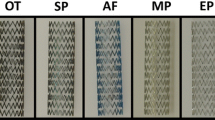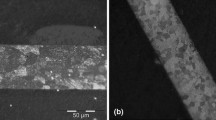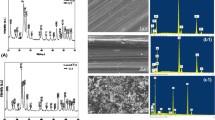Abstract
Immersion testing of medical implants is typically performed under non-loaded conditions to assess susceptibility of metal ion release from a device. However, many implants are subjected to repetitive forces in vivo, which may increase ion release into surrounding tissues. Therefore, the objective of this study was to determine whether fatigue loading of stents with different surface finishes accelerates nickel release. Nitinol stents with an electropolished (EP) oxide or blue oxide (BO) were assigned to the following groups: (1) static immersion without loading, (2) static fluid pressure and bend, (3) dynamic pressure on a static bend, and (4) dynamic bending with static pressure. Immersion fluid was collected periodically and analyzed for nickel concentration using ICP-MS. Results indicated nickel release under dynamic bending was greater by up to 280× for EP and 190× for BO finishes compared to all other groups (p < 0.02). Although not significant (p > 0.27), nickel release under dynamic pressure conditions was up to 50× higher compared to static groups. In addition, BO stents released up to 6× greater levels of nickel compared to EP stents for static immersion, dynamic pressure, and dynamic bending groups (p < 0.05). These findings highlight the impact of fatigue loading on uniform corrosion for different nitinol stent surfaces.











Similar content being viewed by others
References
Decker JF, Trepanier C, Vien L, Pelton AR (2011) The Effect of material removal on the corrosion resistance and biocompatibility of nitinol laser-cut and wire-form products. J Mater Eng Perform 20(4–5):802–806
Trepanier C, Tabrizian M, Yahia L, Bilodeau L, Piron D (1996) Improvement of the corrosion resistance of NiTi stents by surface treatments. MRS Proceedings, Cambridge Univ Press, Cambridge, p. 363
Trepanier C, Tabrizian M, Yahia LH, Bilodeau L, Piron DL (1998) Effect of modification of oxide layer on NiTi stent corrosion resistance. J Biomed Mater Res 43(4):433–440
Zhu L, Trepanier C, Pelton A, Fino JM (2003) Oxidation of nitinol and its effect on corrosion resistance, ASM Materials and Processes for Medical Devices Conference, ASM Publication, Materials Park
Saylor DM, Craven BA, Chandrasekar V, Simon DD, Brown RP, Sussman EM (2018) Predicting patient exposure to nickel released from cardiovascular devices using multi-scale modeling. Acta Biomater 70:304–314
Santin M, Mikhalovska L, Lloyd AW, Mikhalovsky S, Sigfrid L, Denyer SP, Field SN, Teer D (2004) In vitro host response assessment of biomaterials for cardiovascular stent manufacture. J Mater Sci 15(4):473–477
Wataha JC, O’Dell NL, Singh BB, Ghazi M, Whitford GM, Lockwood PE (2001) Relating nickel-induced tissue inflammation to nickel release in vivo. J Biomed Mater Res 58(5):537–544
Lai DW, Saver JL, Araujo JA, Reidl M, Tobis J (2005) Pericarditis associated with nickel hypersensitivity to the Amplatzer occluder device: a case report. Catheter Cardiovasc Interv 66(3):424–426
Rigatelli G, Cardaioli P, Giordan M, Aggio S, Chinaglia M, Braggion G, Roncon L (2007) Nickel allergy in interatrial shunt device-based closure patients. Congenit Heart Dis 2(6):416–420
Gimenez-Arnau A, Riambau V, Serra-Baldrich E, Camarasa JG (2000) Metal-induced generalized pruriginous dermatitis and endovascular surgery. Contact Dermat 43(1):35–40
Slavin L, Tobis JM, Rangarajan K, Dao C, Krivokapich J, Liebeskind DS (2007) Five-year experience with percutaneous closure of patent foramen ovale. Am J Cardiol 99(9):1316–1320
Fukahara K, Minami K, Reiss N, Fassbender D, Koerfer R (2003) Systemic allergic reaction to the percutaneous patent foramen ovale occluder. J Thorac Cardiovasc Surg 125(1):213–214
Kim KH, Park JC, Yoon NS, Moon JY, Hong YJ, Park HW, Kim JH, Ahn Y, Jeong MH, Cho JG (2008) A case of allergic contact dermatitis following transcatheter closure of patent ductus arteriosus using Amplatzer ductal occluder. Int J Cardiol 127(2):e98–e99
Khodaverdian RA, Jones KW (2009) Metal allergy to Amplatzer occluder device presented as severe bronchospasm. Ann Thorac Surg 88(6):2021–2022
Jetty P, Jayaram S, Veinot J, Pratt M (2013) Superficial femoral artery nitinol stent in a patient with nickel allergy. J Vasc Surg 58(5):1388–1390
Köster R, Vieluf D, Kiehn M, Sommerauer M, Kähler J, Baldus S, Meinertz T, Hamm CW (2000) Nickel and molybdenum contact allergies in patients with coronary in-stent restenosis. Lancet 356(9245):1895–1897
Hillen U, Haude M, Erbel R, Goos M (2002) Evaluation of metal allergies in patients with coronary stents. Contact Dermat 47(6):353–356
Iijima R, Ikari Y, Amiya E, Tanimoto S, Nakazawa G, Kyono H, Hatori M, Miyazawa A, Nakayama T, Aoki J (2005) The impact of metallic allergy on stent implantation: metal allergy and recurrence of in-stent restenosis. Int J Cardiol 104(3):319–325
Romero-Brufau S, Best PJ, Holmes DR, Mathew V, Davis MD, Sandhu GS, Lennon RJ, Rihal CS, Gulati R (2012) Outcomes after coronary stent implantation in patients with metal allergy. Circulation 5(2):220–226
Rabkin DG, Whitehead KJ, Michaels AD, Powell DL, Karwande S (2009) Unusual presentation of nickel allergy requiring explantation of an Amplatzer atrial septal occluder device. Clin Cardiol 32(8):E55–E57
McLucas E, Rochev Y, Carroll WM, Smith TJ (2008) Analysis of the effects of surface treatments on nickel release from nitinol wires and their impact on candidate gene expression in endothelial cells. J Mater Sci Mater Med 19(3):975–980
Wever DJ, Veldhuizen AG, de Vries J, Busscher HJ, Uges DRA, van Horn JR (1998) Electrochemical and surface characterization of a nickel-titanium alloy. Biomaterials 19(7–9):761–769
Wu S, Chu PK, Liu X, Chung C, Ho J, Chu C, Tjong S, Yeung K, Lu W, Cheung K (2006) Surface characteristics, mechanical properties, and cytocompatibility of oxygen plasma-implanted porous nickel titanium shape memory alloy. J Biomed Mater Res, Part A 79(1):139–146
Pérez LM, Gracia-Villa L, Puértolas JA, Arruebo M, Irusta S, Santamaria J (2009) Effect of Nitinol surface treatments on its physico-chemical properties. J Biomed Mater Res, Part B 91(1):337–347
Cui Z, Man H, Yang X (2005) The corrosion and nickel release behavior of laser surface-melted NiTi shape memory alloy in Hanks’ solution. Surf Coat Technol 192(2):347–353
Thierry B, Tabrizian M, Trepanier C, Savadogo O, Yahia LH (2000) Effect of surface treatment and sterilization processes on the corrosion behavior of NiTi shape memory alloy. J Biomed Mater Res 51(4):685–693
Sullivan SL, Dreher M, Zheng J, Chen L, Madamba D, Miyashiro K, Trépanier C, Nagaraja S (2015) Effects of oxide layer composition and radial compression on nickel release in nitinol stents. Shape Mem Superelasticity 1(3):319–327
Clarke B, Carroll W, Rochev Y, Hynes M, Bradley D, Plumley D (2006) Influence of nitinol wire surface treatment on oxide thickness and composition and its subsequent effect on corrosion resistance and nickel ion release. J Biomed Mater Res, Part A 79(1):61–70
Acknowledgements
This study was made possible through research collaborative agreements between FDA and Medical Device Testing (now Element Materials Technology Corporation) and G. Rau Inc. The authors would like to thank FDA researchers Shiril Sivan and Stacey Sullivan for technical assistance and David Saylor for manuscript review. The authors would like to acknowledge the FDA White Oak Nanotechnology Core Facility for instrument use, scientific and technical assistance. The findings and conclusions in this paper have not been formally disseminated by the Food and Drug Administration, are the views of the authors, and should not be construed to represent any agency determination or policy. The mention of commercial products, their sources, or their use in connection with material reported herein is not to be construed as either an actual or implied endorsement of such products by Department of Health and Human Services.
Author information
Authors and Affiliations
Corresponding author
Rights and permissions
About this article
Cite this article
Nagaraja, S., Chandrasekar, V., Ormonde, D. et al. The Impact of Fatigue Testing and Surface Processing on Nickel Release in Nitinol Stents. Shap. Mem. Superelasticity 4, 462–471 (2018). https://doi.org/10.1007/s40830-018-00196-0
Published:
Issue Date:
DOI: https://doi.org/10.1007/s40830-018-00196-0




